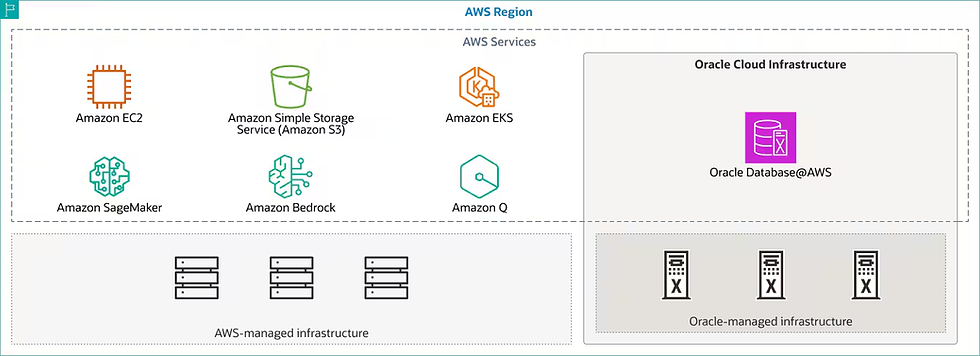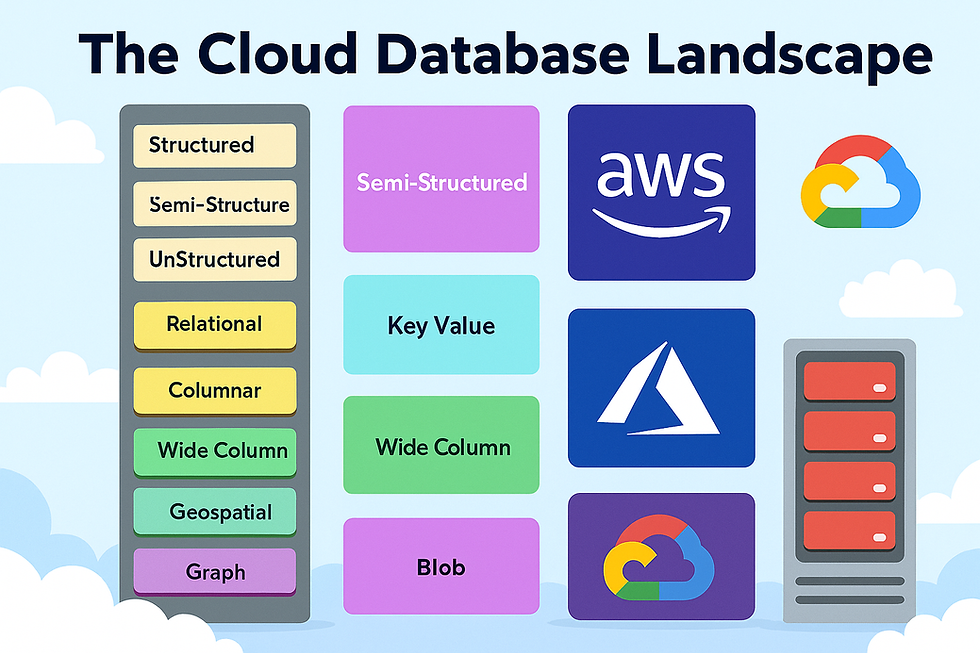Understanding Network Topologies for Oracle Database@AWS: A Practical, Real-World Guide
- AiTech
- 1 day ago
- 5 min read
Deploying Oracle Database@AWS is not just about provisioning a database or choosing the right Exadata configuration. The foundation of a reliable deployment lies in selecting the right network topology. Network architecture determines latency, security, availability, cost, and long-term scalability.
Oracle Database@AWS gives cloud architects several ways to connect applications with the database layer, ranging from simple single–availability–zone deployments to multi-region and hybrid scenarios. Each topology is suited for a different business requirement—latency-sensitive workloads, multi-line-of-business architectures, DR architectures, or hybrid modernization programs.
This blog breaks down these topology options in clear, practical language so you can confidently choose the right architecture for your environment.
Why Network Topology Matters for Oracle Database@AWS
Before selecting a topology, it helps to understand how Oracle Database@AWS is organized.
A few core principles apply to all topologies:
Each VM cluster belongs to a single ODB (Oracle Database@AWS) network in one availability zone.
Multiple VM clusters—Autonomous or Exadata—can run within the same ODB network.
An ODB network can be peered with only one VPC in the region.
VM clusters cannot be moved between ODB networks after deployment.
ODB networks can be shared across AWS accounts within the same organization.
AWS Transit Gateway (TGW) or Cloud WAN may be used to connect multiple VPCs to ODB networks.
IPs for the database cluster come from the CIDR assigned to the Client subnet.
CIDR ranges also require attention:
Client subnet must be at least /27 (Oracle recommends /24 for future growth).
Backup subnet for Autonomous DB should be at least /28.
No CIDR block may overlap with any AWS VPC, OCI VCN, or external database clients.
These fundamentals are important because they influence which topology you can use and how traffic flows throughout the system.
Network Topology Options for Oracle Database@AWS
Oracle Database@AWS supports five primary network architectures:
Same availability zone connectivity
Same availability zone with multiple VM clusters
Cross-VPC connectivity in the same region (Hub-and-Spoke)
Cross-region connectivity (Hub-and-Spoke)
On-premises hybrid connectivity (Hub-and-Spoke)
Each model is explained below:
1. Same Availability Zone Connectivity

This is the most straightforward topology and provides the lowest latency because both the database and applications reside in the same AWS availability zone.
When to use this topology
Latency-sensitive OLTP workloads
Real-time financial or industrial applications
Applications requiring extremely fast round-trip times
Simpler deployments without multi-VPC complexity
How it works
The Application VPC is in the same availability zone as the ODB network.
An ODB peering connection links the VPC and the database.
Applications in separate subnets connect directly to Oracle Database@AWS.
Why it works well
No cross-zone charges
No transit through Transit Gateway
Lowest possible network latency
This is the recommended model whenever application and database can be colocated in the same AZ.
2. Same Availability Zone with Multiple VM Clusters

Some organizations need multiple isolated environments within the same availability zone. This may be for separating:
Dev, QA, and Prod
Multi-tenant customer environments
Separate business domains
Compliance and data segmentation requirements
How this topology functions
Multiple VM clusters (Autonomous or Exadata) run on the same Exadata Infrastructure.
Each VM cluster has its own ODB network.
The same Application VPC may access multiple VM clusters if required.
ODB networks can be shared across different AWS accounts, enabling strong isolation.
Benefits
Logical and security isolation
Can scale VM clusters independently
Lower cost compared to separate dedicated hardware
This topology is popular for enterprises running many teams or separate product workloads.
3. Cross-VPC Connectivity in the Same Region (Hub-and-Spoke)

This is one of the most commonly used enterprise architectures.
Instead of connecting one VPC directly to the ODB network, multiple VPCs connect through a hub using AWS Transit Gateway or Cloud WAN.
Use cases
Organizations with many application teams and VPCs
Centralized access to a single database for multiple LoBs
Traffic inspection via firewalls before reaching the database
Multi-AZ application architectures needing a shared database backend
How it works
A hub VPC peers with the ODB network.
All other VPCs (spokes) route traffic to the hub using TGW or Cloud WAN.
Optionally, a firewall cluster in the hub can inspect inbound database connections.
Design considerations
Latency increases slightly due to TGW routing
Ensure Transit Gateway route tables are configured correctly
Keep the TGW attachments in the same AZ for best performance
This topology is ideal for regulated industries and large enterprise environments where segmentation and central governance are critical.
4. Cross-Region Connectivity (Hub-and-Spoke Across Regions)

Some organizations operate across multiple AWS regions and still require centralized or synchronized access to Oracle Database@AWS.
This topology connects multiple regions using:
A Transit Gateway in each region
A peering connection between the Transit Gateways
Use cases
Cross-region data replication
DR/BCP architecture
Region-to-region analytics and reporting
Centralized management of databases from a remote region
Key design points
Latency varies by geography—validate application performance
Cross-region bandwidth charges may apply
Cloud WAN can replace TGW for global connectivity
A consistent routing strategy is critical for multi-region deployments
This is the preferred design for global enterprises running workloads in multiple regions with centralized data operations.
5. On-Premises (Hybrid) Connectivity Using Hub-and-Spoke

Hybrid connectivity is essential for organizations not fully migrated to AWS, or for those maintaining critical workloads on-premises.
This topology extends on-prem connectivity to the ODB network through a Transit Gateway hub.
Use cases
Gradual migration of Oracle workloads to cloud
Hybrid DR strategy (on-prem primary, cloud DR or vice versa)
Applications that must remain on-prem due to compliance
Mixed-mode deployments during modernization
How it works
On-prem connects to AWS through VPN or Direct Connect
Transit Gateway routes traffic between on-prem and ODB network
Database access is uniform across cloud and on-prem environments
Oracle recommendations
Use Direct Connect for predictable performance
Place the TGW attachment in the same AZ as the ODB network
Validate latency-sensitive workloads before production cutover



Comments